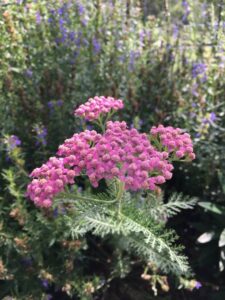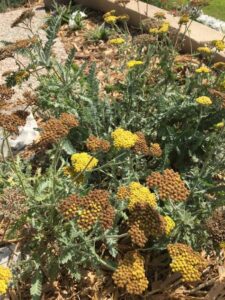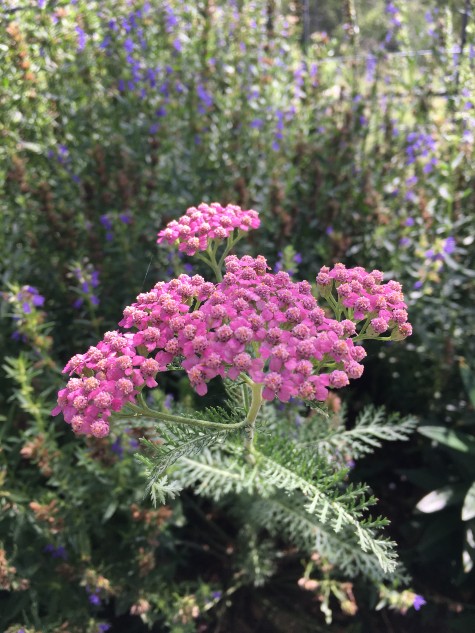Achillea Millefolium (Common Yarrow)
by CMG Kay P.
One might expect the Featured Plant to be a vegetable since we are right now being pelted by the garden with tomatoes, peppers, beans, eggplants, cucumbers, but no. This month’s pick is Achillea Millefolium, common yarrow. Why? After being overrun with more vegetables than two people could eat and overcome by too much laziness to can, pickle, and preserve it all, and neighbors running to hide from me when they see me coming with more sacks of produce to give away, I’ve decided it might be time to convert some garden beds to cutting flowers, and yarrow is a useful plant for this purpose.

Photo by CMG Kay P.
Last month’s choice was a start: purple coneflower. Other bloomers like cosmos and zinnia are now providing lots of blooms for the house, but a good filler is needed for vase bouquets. Achillea millefolium provides heads of tiny blooms that contrast with larger ones and its leafy fernlike greens keep single stems upright in an arrangement. The plants look good in the garden as well and cutting promotes more blooms.

Photo by CMG Kay P.
Common yarrow from Europe and Asia was originally introduced to America in colonial times, and has since naturalized throughout the U. S. These species plants are noted for producing deeply-dissected, fern-like, aromatic, medium green foliage and tiny, long-lasting flowers that appear in dense, flattened, compound corymbs (to 2-4” across) throughout the summer on stems typically rising 1-2’ tall. Foliage has a strong, somewhat spicy aroma that persists when used in dried arrangements. They are easily grown from seed and transplanted. Cultivars and hybrids of common yarrow, most of which have stronger stems, more upright habits and larger flowers, have become popular flowering plants for ornamental gardens. Cultivars extend the range of flower colors to include pinks, reds, creams, yellows and bicolor pastels.

Photo by CMG Kay P.

Photo by CMG Kay P.
The genus name Achillea refers to Achilles, hero of the Trojan Wars in Greek mythology, who used the plant medicinally to stop bleeding and to heal the wounds of his soldiers. Millefolium means “thousand-leaved” in reference to the highly dissected foliage. Plants do well in average garden soils and tolerate poor soils as long as drainage is good. Plants also tolerate hot, humid summers and drought. Plant stems tend to flop in hot, humid climates such as South Texas, and/or if grown in moist, rich soils. Consider cutting back plant stems in late spring before flowering to reduce overall plant height. Cutting plants back to lateral flower buds after flowering will tidy the planting and encourage additional bloom. Plants may also be cut back to basal foliage after bloom. Divide clumps as needed (every 2-3 years) to maintain vitality of the planting. Stem rot, powdery mildew and rust are occasional disease problems. So, if you too would rather cut a bouquet, make some lemonade, and rest in the shade, convert some of those vegetable beds to cutting flowers. Beauty will be worth it!
Yarrow Attributes:
Size: 1 -3 ft
Sun: Sun, Part Shade
Soil: Prefers well-drained soil
Water: Medium
Color/Season: White, Pink / April – Early July
Other: Deer resistant
Family: Asteraceae (Aster Family)
